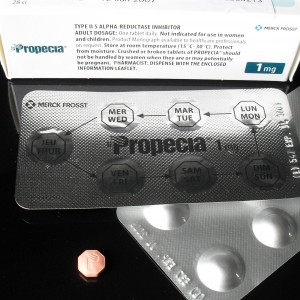
Finasteride (Propecia®) has been in use since the 1990s and is an indispensable part of hair care for thousands of men. Finasteride works by decreasing the levels of the hormone dihydrotestosterone (DHT) (1). Higher amounts of DHT in men promote the shrinking of hair follicles, resulting in thinning/loss of hair. Daily use of finasteride has been shown to decrease levels of DHT and decrease hair loss (2). After six to twelve months of treatment, a noticeable effect (10% increase in hair count) may be seen. Thus you should be budgeting about a year before determining whether finasteride is the right product for you. Also be aware that the hormone reduction is temporary. To continue seeing positive effects, treatment must be maintained.
Since finasteride is an oral medication, some side effects may occur. On average, 2% of patients have side effects (3), with side effects varying from patient to patient. Finasteride can cause an unknown amount of side effects, with the well-known side effects being depression, suicidal ideation, gynecomastia, and sexual side effects (2,4). Sexual side effects are the main concern for male patients (4), even though finasteride does not seem to increase the risk of sexual dysfunction in general (5). The prevalence of erectile dysfunction varies widely from 2%-86% in the general population depending on age (5), whereas the prevalence of erectile dysfunction in men using finasteride is only 0.5-3% (4); however, in some cases the effects of finasteride may be long-lasting or even permanent (4). It is uncertain how many men in the general population experience long-lasting sexual side effects due to previous or current finasteride use.
A few studies have been conducted to investigate the benefits of combining finasteride with other hair loss products (6,7). Minoxidil (Rogaine®) enters the skin easily, and therefore can be applied as a foam or topical solution, lowering the risk of side effects and unwanted complications. Gentle warming of the minoxidil solution prior to application may also lead to better results. Minoxidil and oral finasteride can be used in combination to enhance regrowth of hair. Finasteride and minoxidil act differently in the body, so used in combination, the results could be synergistic, leading to superior regrowth.
More recently, finasteride dissolved in minoxidil for topical use has been investigated (6). When applied topically, finasteride mixed with minoxidil was found to perform just as effectively as oral treatment, without any reports of sexual side effects. Caution must be taken when interpreting these results, as this is an initial report of a small number of men using this combination. Topical finasteride is also not FDA approved. Further investigation must be completed before finasteride could be approved for topical use.
Remember to always consult a hair loss specialist to determine which course of treatment is the best option for you. A specialist will be able to tell you whether medications such as finasteride and minoxidil may be appropriate for you, or whether hair transplants is an option. Keep in mind there are always other ways to decrease the amount of hair loss, talk to your specialist about your diet, exercise, and hair care maintenance.
Article by: Dr. C.D. Studholme, Mediprobe Research Inc.
- Roberts JL, Fiedler V, Imperato-McGinley J, Whiting D, Olsen E, Shupack J, et al. Clinical dose ranging studies with finasteride, a type 2 5alpha-reductase inhibitor, in men with male pattern hair loss. J Am Acad Dermatol. 1999 Oct;41(4):555–63.
- Kaufman KD, Olsen EA, Whiting D, Savin R, DeVillez R, Bergfeld W, et al. Finasteride in the treatment of men with androgenetic alopecia. Finasteride Male Pattern Hair Loss Study Group. J Am Acad Dermatol. 1998 Oct;39(4 Pt 1):578–89.
- Arndt KA, Hsu, J.T.S. Manual of dermatologic therapeutics. In: 7th ed. Lippincott Williams & Wilkins; p. 339–40.
- Ali AK, Heran BS, Etminan M. Persistent Sexual Dysfunction and Suicidal Ideation in Young Men Treated with Low-Dose Finasteride: A Pharmacovigilance Study. Pharmacotherapy. 2015 Jul;35(7):687–95.
- Prins J, Blanker MH, Bohnen AM, Thomas S, Bosch JLHR. Prevalence of erectile dysfunction: a systematic review of population-based studies. Int J Impot Res. 2002 Dec;14(6):422–32.
- Chandrashekar B, Nandhini T, Vasanth V, Sriram R, Navale S. Topical minoxidil fortified with finasteride: An account of maintenance of hair density after replacing oral finasteride. Indian Dermatol Online J. 2015;6(1):17.
- Tanglertsampan C. Efficacy and safety of 3% minoxidil versus combined 3% minoxidil / 0.1% finasteride in male pattern hair loss: A randomized, double-blind, comparative study. J Med Assoc Thai. 2012;95(10):1312–6.












